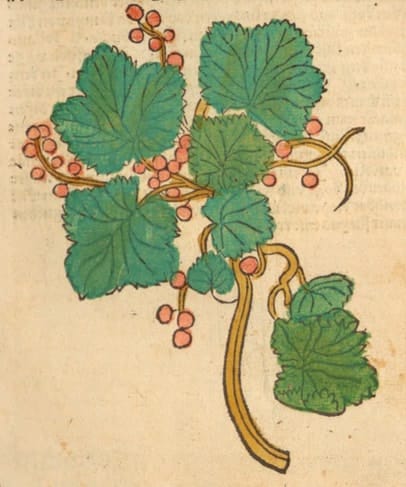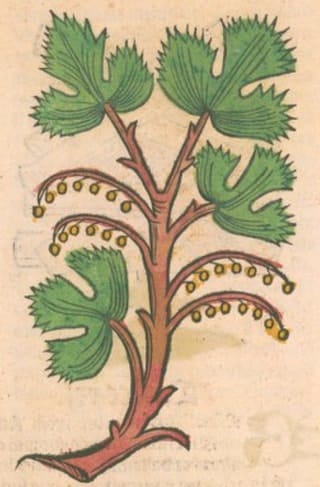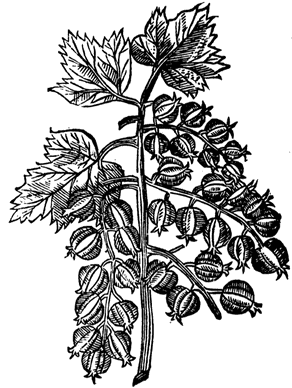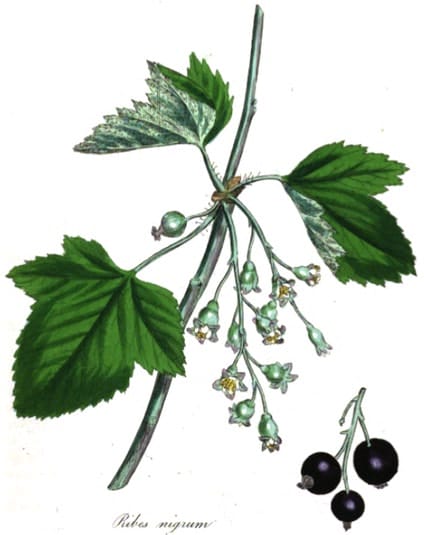Ribes, Currant
Currans
 Gart der Gesundheit, Cuba, 1485
Gart der Gesundheit, Cuba, 1485 |
 Ortus Sanitatis, Meydenbach, 1491
Ortus Sanitatis, Meydenbach, 1491 |
 Parkinson, Theatrum Botanicum, 1640
Parkinson, Theatrum Botanicum, 1640

|

|
Medical Botany, Woodville, Hooker, Vol. 3, 1832
Botanical name:
Ribes spp.
- R. nigrum–Black Currant
- Ribes rubrum–Red Currant
Parts used:
Fruit; rarely the leaf
Temperature & Taste:
Neutral (slightly Cool), dry (although they are also moist). Sweet, Sour. (Black are more Sweet, Red more Sour)
Classifications:
3D. CORDIALS & CARDIACS
4c. CARDIAC. 4e. STOMACHIC. 4g. HEPATIC. 4h. NEPHRITIC
Uses:
1. Tonifies and Nourishes the Yin and Blood:
–Maimonides said ‘Currants are faithful friends of the Liver; they fatten it, strengthen it, color the blood and ripen the humors’.
-nourish the blood and Liver, good in Anemia and female weakness
-benefits immunity
-Pre-menstrual Syndrome and Menopause
-good during Pregnancy and to prevent Miscarriage.
-Arthritic disorders and Rheumatism.
-Wind diseases from Blood and Yin deficiency: Dizziness, Epilepsy, Multiple Sclerosis; benefits nervous systems
-auxiliary in Cancer
2. Clears Heat from the Liver and Blood:
-high cholesterol, Hypertension
-Headache, sore Eyes, Dizziness, Vertigo
-Bleeding from Heat
-‘allays Choler, resist Putrefaction’
3. Benefits the Lungs, Stops Cough:
-Cough or Wheezing from Heat or weakness
-used similarly to Raisins
4. Clears Heat, Quenches Thirst:
-Fever, the thirst of Fevers (especially the Rob)
-excessive appetite from Stomach heat.
-Diarrhea, Dysentery from heat.
5. Externally:
-The Syrup can be used as Syrup of Mulberries for inflammations and sores of the Mouth and Throat
Dose:
Decoction: 5–20 grams
10–20 grams can be eaten daily
Of the Juice: 1–3 oz.
Main Combinations:
1. Common Decoction, a gentle laxative used after Trauma, chronic Illness, and as a vehicle for various medicines, with Prunes, Licorice, Aniseed, Fennel.
2. Cough:
i. chronic, persistent with Hyssop, Licorice
ii. from Phlegm with Elecampane, Coltsfoot, Licorice
iii. chronic Cough, with Jujube, Fig, Fenugreek, Maidenhair, Cinnamon, Hyssop, Orris, Licorice, Aniseed, Almond, Gum Arabic, Tragacanth (as in A Sound and Experienced Electuary)
iv. from Cold Phlegm, with Horehound, Licorice, Maidenhair, Hyssop, Aniseed, Fennel root, Fenugreek, Orris, Linseed, Fig (as in Syrup of Horehound)
3. Cold-Phlegm Cough, Asthma, Wheezing or Consumption, with Horehound, Licorice, Celery root, Maidenhair, Hyssop, Aniseed and Figs
4. Asthma:
i. with Elecampane, Coltsfoot, Licorice, Gentian, Almonds, Cinnamon and Figs
ii. with Elecampane Coltsfoot, Licorice, Sage, Maidenhair, Violet, Hyssop, Pennyroyal, Thyme, Parsley root, Aniseed, Fennel seed, Mallow seed, Agaric, Fig (as in Syrup for Asthma)
5. Lung Ulcers, Scrofula: Sarsaparilla (6 oz.), Currants (8 oz.). Boil in 12 lbs. water until one quarter has boiled away. In the strained decoction slake Quick Lime (½ pound), and when it has settled, decant the clear liquor. Dose: 3 oz. (A Treatise on Foreign Drugs, Geoffroy and Thicknesse, 1749)
6. Bleeding from the Lungs, with Pine nut, Licorice, Cinnamon
7. Consumption, with Maidenhair, Hyssop, Balm, Licorice and Peony root
8. Wind diseases from deficiency, with Chebulic Myrobalan, Cinnamon, Nutmeg, Aloeswood, Clove and Conserve of Rose (Wirtzung)
9. Amenorrhea from Blood deficiency, with Asparagus root, Butchers Broom root, Balm, Madder, Cyperus rotundus, Licorice
10. To cleanse the Blood:
i. with Sarsaparilla, used for Scrofula, Lymphadenitis, Running Ulcers, Rheumatic Pains, Edema, Gangrene, Herpes, Eczema etc. (as in Decoction Liberans)
ii. with Dandelion, Cleavers, Couch grass, roots of Fennel and Parsley (as in Decoction to Purify)
11. Spring Cure, Birch leaf, Raspberry leaf, Blackberry leaf, Black Currant leaf (Meyer)
12. Jaundice in Children, make a paste of Currants and add a little Rhubarb powder
13. Arthritic complaints with deficiency, with Guaiacum, China root, Licorice, Calamus, Cinnamon, Galangal (as in Decoction for Arthritis)
14. As a gargle for Sore Throat, Tonsillitis, with Rose, Pomegranate peel, Galls, Licorice (Wirtzung)
Major Formulas:
Electuary of Currants
Common Decoction
Decoction Liberans
Decoction to Purify
Decoction of Dodder of Thyme (Mesue)
Decoction for Arthritis (Mynsichts)
Syrup of Horehound
Syrup for Asthma (Wirtzung)
Confection for Dizziness and Vertigo
Electuary For Spitting Blood (Wirtzung)
A Sound and Experienced Electuary (Mesue)
Confection for Cold Cough
Electuary for Jaundice in Children
Cautions:
Not suitable in Damp and Spleen weakness.
Main Preparations used:
Preserved Berries, Juice, and Rob (thickened Juice)
1. Conserve of Black Currant Leaf:
i. Black Currant leaf, beat to a fine pulp (1 part), White Sugar (2 parts). Beat together. With the heat of a water-bath evaporate to the thickness of a pill mass.
2. Juice of Black Currants:
i. Ripe Black Currants, any quantity. Bruise in a mortar, set aside in a cellar for several days, then express strongly, strain the juice through flannel and preserve in long-necked bottles. (Dispensatorium Fuldense, 1791)
3. Syrup of Black Currants:
i. Depurated Juice of Black Currants (1 lb.), White Sugar (2 lbs.). With gentle heat, form a syrup. (Pharmacopoeia Suecica, 1817)
4. Rob of Black Currants:
i. Ripe Black Currants, any quantity. Boil with a little water in a covered tin vessel, constantly stirring until the berries burst; strain through a sieve and express strongly. To each pound of juice add Sugar (½ pound) and evaporate to a proper consistency, removing th scum as its formed. (Pharmacopoeia Amstelodamensis, 1792)
5. Spirit of Black Currants:
i. Ripe Black Currants (2 parts). Bruise after infusing in warm water. Leave to ferment, then distil with fresh leaves of Black Currants (one-quarter part), Proof Spirit (1 ½ parts), Water (12 parts). Distil 3 parts. (Pharmacopee Usuelle, Louvain, 1821)
- Extra Info
- Research
–Genus Ribes Linn. (Grossulariaceae): A comprehensive review of traditional uses, phytochemistry, pharmacology and clinical applications.
